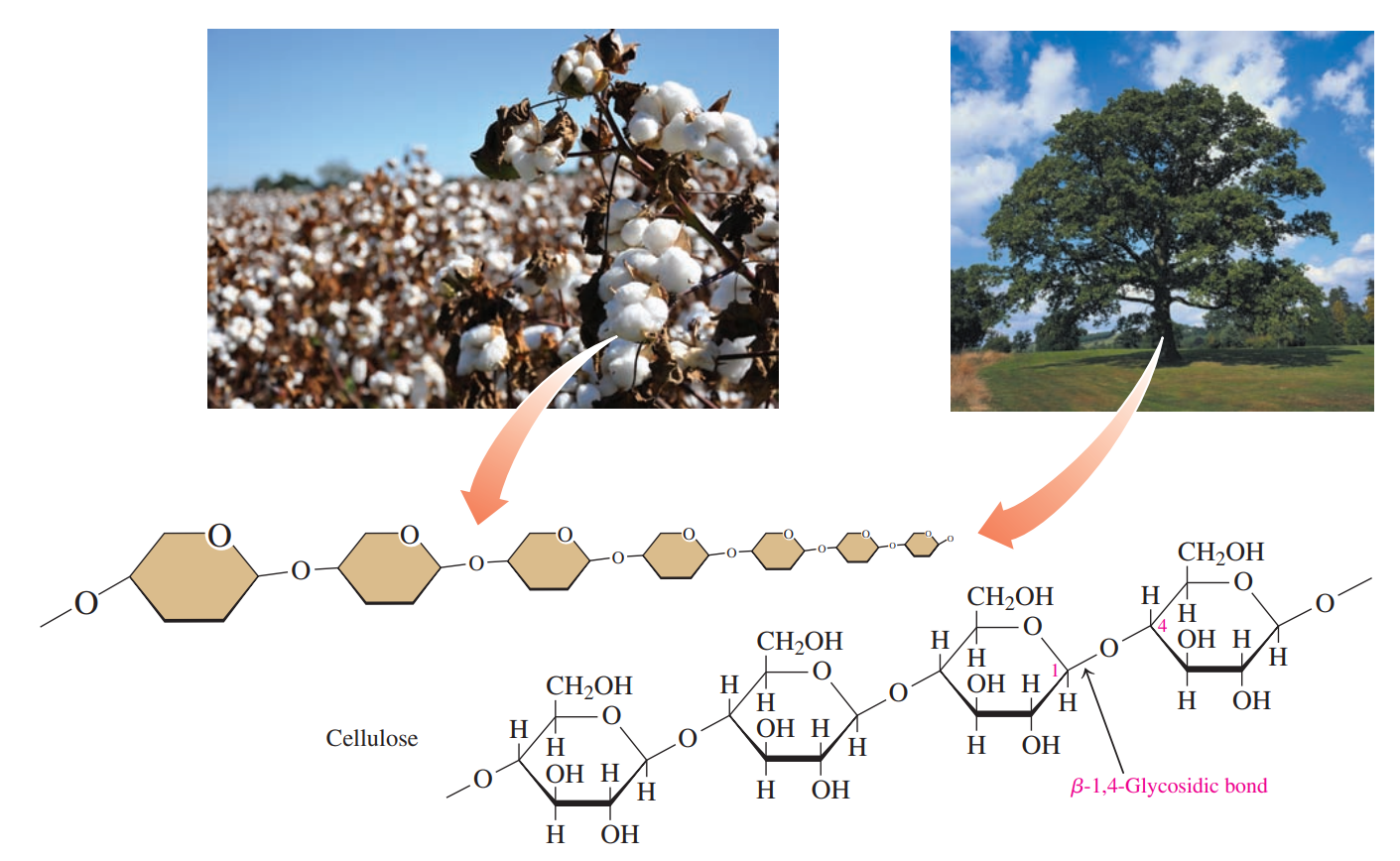Chapter 13: Carbohydrates
13.1: Carbohydrates
- Carbohydrates are all made up of carbon, hydrogen, and oxygen.
- Photosynthesis: Energy from the Sun is used to combine the carbon atoms from carbon dioxide and the hydrogen and oxygen atoms of water into the carbohydrate glucose.
- In the body, glucose is oxidized in respiration.
- Respiration: A series of metabolic reactions which releases chemical energy to do work in cells.
- Carbon Cycle: The combination of photosynthesis and respiration, in which energy from the Sun is stored in plants by photosynthesis and made available to us when the carbohydrates in our diets are metabolized.
Types of Carbohydrates
Monosaccharides (CH2O) n
- The simplest carbohydrate.
- These cannot be split or hydrolyzed into smaller carbohydrates.
- These have chains of three to eight carbon atoms, one in a carbonyl group and all the others attached to hydroxyl groups.
- Aldopentose: A five-carbon monosaccharide that is an aldehyde.
- Ketohexose: A six-carbon monosaccharide that is a ketone.
Disaccharides (C12H22O11)
- These consist of two monosaccharide units joined together
- These can be split into two monosaccharide units.
Polysaccharides (Cn(H2O)n-1)
- These are carbohydrates that contain many polymers.
- In the presence of an acid or an enzyme, a polysaccharide can be completely hydrolyzed to yield many monosaccharide molecules.

13.2: Chiral Molecules
Stereoisomers: The atoms are bonded in the same sequence but differ in the way they are arranged in space.
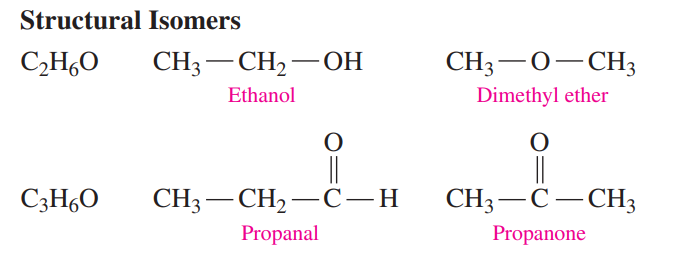
When the mirror images of organic molecules cannot be completely matched, they are non-superimposable.
Objects such as hands that have non-superimposable mirror images are chiral.
When the mirror image of an object is identical and can be superimposed on the original, it is achiral.
Chiral Carbon: A carbon compound is chiral if it has at least one carbon atom bonded to four different atoms or groups.
Enantiomers: When stereoisomers cannot be superimposed.
- Emil Fischer: He devised a simplified system for drawing stereoisomers that shows the arrangements of the atoms around the chiral centers.
Fischer Projection: It is used to represent a three-dimensional structure of enantiomers.
- Vertical lines represent bonds that project backward from a carbon atom and horizontal lines represent bonds that project forward.
- It can also be drawn for compounds that have two or more chiral carbons.
13.3: Fischer Projections of Monosaccharides
- The —OH group on the chiral carbon farthest from the carbonyl group is used to determine the D or L stereoisomer.
- The vertical carbon chain is numbered starting from the top carbon.
- In each pair of mirror images, it is important to see that the —OH groups on chiral atoms are reversed so that they appear on the opposite sides of the molecule.
- Glucose: Also known as dextrose and blood sugar; mostly found in fruits, vegetables, corn, syrup and honey.
- D-Glucose: A building block of the disaccharides sucrose, lactose, and maltose, and polysaccharides such as amylose, cellulose, and glycogen.
- Galactose: An aldohexose that is obtained from the disaccharide lactose, which is found in milk and milk products.
- It is important in the cellular membranes of the brain and nervous system.
- Galactosemia: An enzyme needed to convert galactose to glucose is missing.
- The accumulation of galactose in the blood and tissues can lead to cataracts, mental retardation, failure to thrive, and liver disease.
- The treatment for this is the removal of all galactose-containing foods.
- Fructose: A ketohexose; it is the sweetest of carbohydrates, almost twice as sweet as sucrose.
- This characteristic makes fructose popular with dieters because less fructose, and therefore fewer calories, is needed to provide a pleasant taste.
13.4: Haworth Structures of Monosaccharides
- Haworth structures: These are the atom rings produced from the reaction of a carbonyl group and a hydroxyl group in the same molecule.
Drawing Haworth Structures
Step 1: Turn the Fischer projection clockwise by 90°.

Step 2: Fold the horizontal carbon chain into a hexagon and bond the O on carbon 5 to the carbonyl group.

Step 3: Draw the new —OH group on carbon 1 below the ring to give the ɑ isomer or above the ring to give the β isomer.
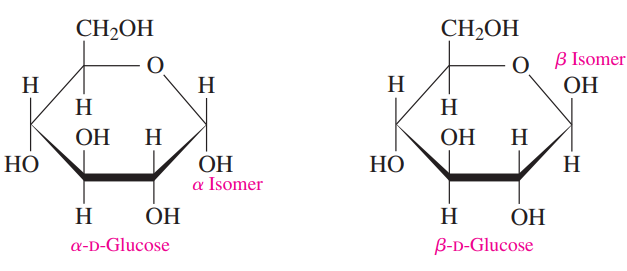
Mutarotation of ɑ- and β-D-Glucose
Mutarotation: Each isomer converts to the open chain and back again.
As the ring opens and closes, the —OH group on carbon 1 can form either the ɑ or β isomer.

Haworth Structures of Galactose
Galactose is an aldohexose that differs from glucose only in the arrangement of the —OH group on carbon 4.
Thus, its Haworth structure is similar to glucose, except that the —OH group on carbon 4 is drawn above the ring.

Haworth Structures of Fructose
- The Haworth structure for fructose is a five-atom ring with carbon 2 at the right corner of the ring.
- The cyclic structure forms when the —OH group on carbon 5 reacts with carbon 2 in the carbonyl group.
- The new —OH group on carbon 2 gives the ɑ or β isomers of fructose.
13.5: Chemical Properties of Monosaccharides
- In an aldose, the aldehyde group can be oxidized to a carboxylic acid.
- The carbonyl group in both an aldose and a ketose can be reduced to give a hydroxyl group.
- The hydroxyl groups can react with other compounds to form a variety of derivatives that are important in biological structures.
Oxidation of Monosaccharides
An aldehyde group with an adjacent hydroxyl can be oxidized to a carboxylic acid by an oxidizing agent.
The sugar acids are named by replacing the –ose ending of the monosaccharide with –onic acid.
Reducing Sugar: A carbohydrate that reduces another substance.
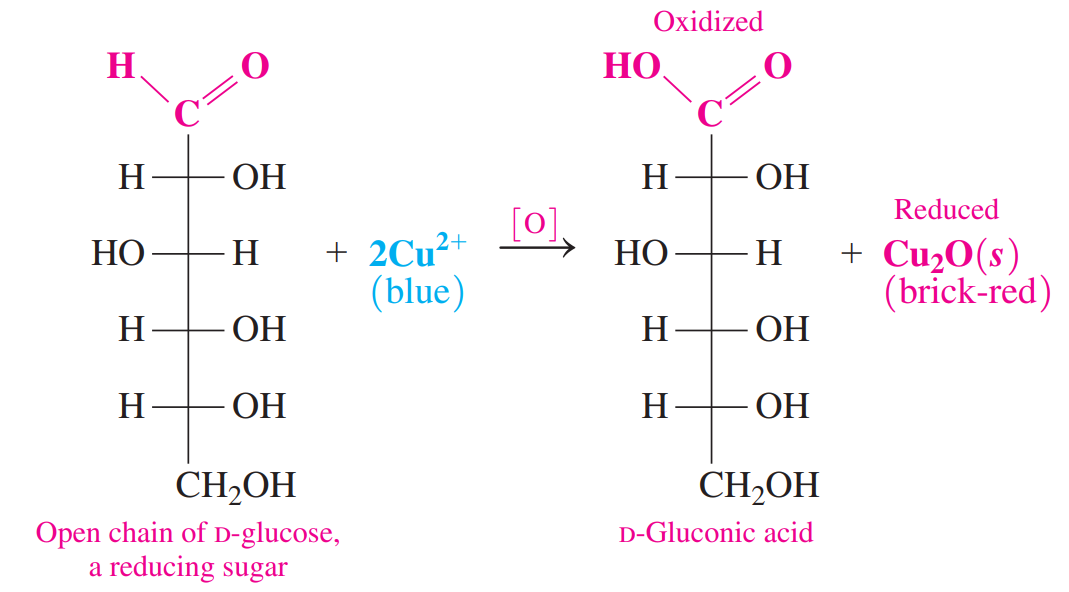
Reduction of Monosaccharides
The reduction of the carbonyl group in monosaccharides produces sugar alcohols — alditols.
D-Sorbitol: D-Glucose is reduced to D-glucitol.
The sugar alcohols are named by replacing the –ose ending of the monosaccharide with –itol.
Sugar alcohols such as d-sorbitol, d-xylitol from d-xylose, and d-mannitol from d-mannose are used as sweeteners in many sugar-free products such as diet drinks and sugarless gum as well as products for people with diabetes.
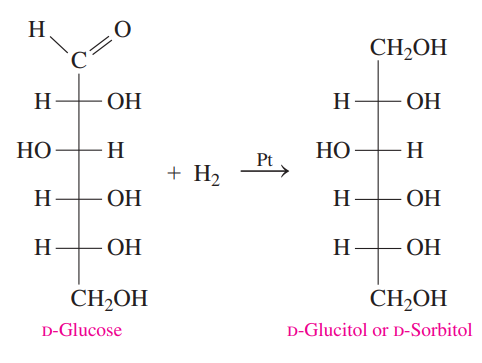
13.6: Disaccharides
Disaccharide: It is composed of two monosaccharides linked together.
- The most common disaccharides are maltose, lactose, and sucrose.
When two monosaccharides combine in a dehydration reaction, the product is a disaccharide.
Maltose: It is obtained from starch and is found in germinating grains.
In maltose, a glycosidic bond forms between the —OH groups of carbons 1 and 4 of two ɑ-D-glucose molecules with a loss of a water molecule.
Glycosidic Bond: An ether bond that connects two monosaccharides.
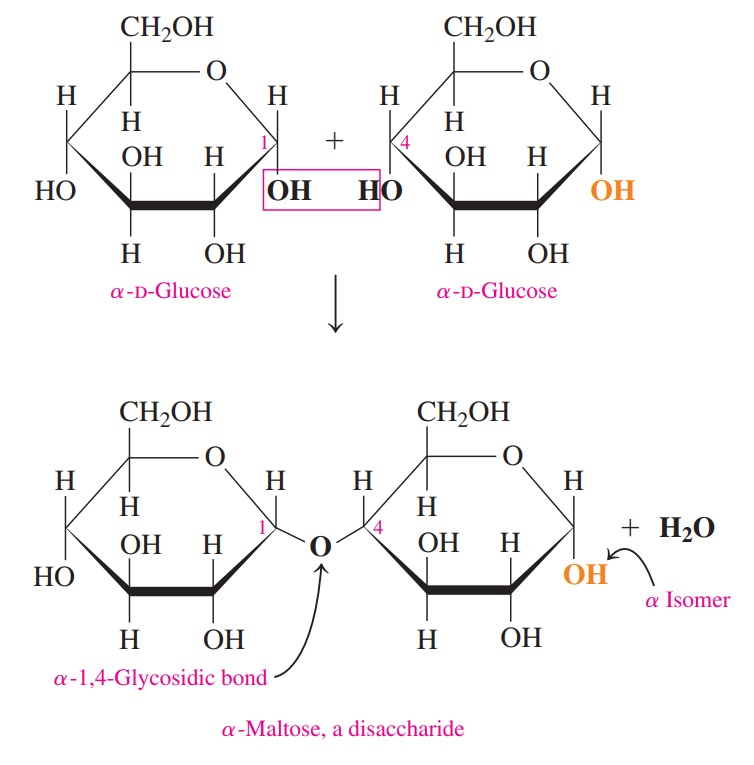
Lactose: A disaccharide found in milk and milk products.
- The bond in lactose is a β-1,4-glycosidic bond because the —OH group on carbon 1 of β-D-galactose forms a glycosidic bond with the —OH group on carbon 4 of a d-glucose molecule.
- Because d-glucose still has a free —OH group on carbon 1, it can form an open chain, which allows lactose to form both ɑ or β isomers.
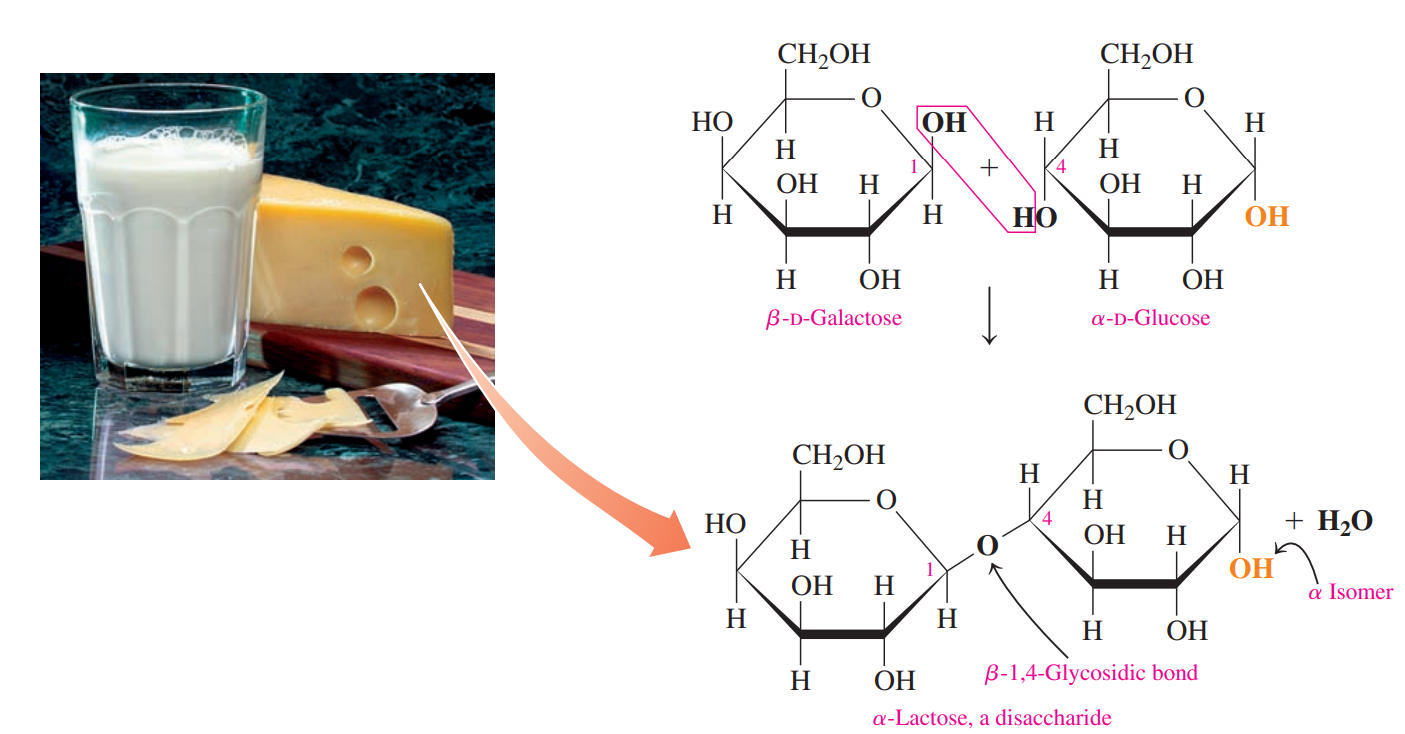
Sucrose: It consists of an ɑ-D-glucose and a β-D-fructose molecule joined by an ɑ, β-1, 2-glycosidic bond.
The glycosidic bond in sucrose is between carbon 1 of glucose and carbon 2 of fructose.
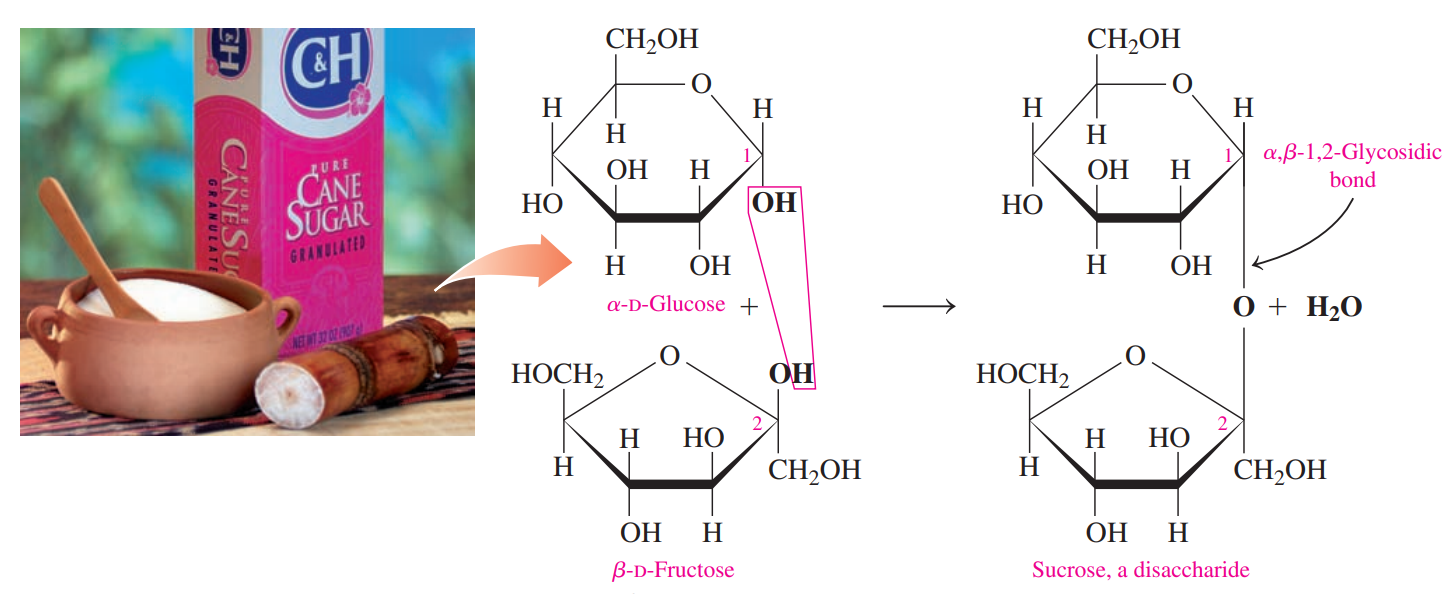
13.7: Polysaccharides
Polysaccharide: A polymer of many monosaccharides joined together.
Starch (C6H10O5)n**:** A storage form of glucose in plants is found as insoluble granules in rice, wheat, potatoes, beans, and cereals.
- Amylose: It makes up about 20% of starch, and consists of 250 to 4000 ɑ-D-glucose molecules connected by ɑ-1,4-glycosidic bonds in a continuous chain.
- Amylopectin: It makes up as much as 80% of starch, and is a branched-chain polysaccharide. The glucose molecules are connected by ɑ-1,4-glycosidic bonds.
Dextrins (C18H32O16): Starches hydrolyze easily in water and acid to give smaller saccharides, which then hydrolyze to maltose and finally glucose.
Glycogen (C24H42O21): A polymer of glucose that is stored in the liver and muscles of animals.
- It is hydrolyzed in our cells at a rate that maintains the blood level of glucose and provides energy between meals.
- In glycogen, the glucose units are joined by ɑ-1,4-glycosidic bonds, and branches occurring about every 10 to 15 glucose units are attached by ɑ-1,6-glycosidic bonds.
Cellulose ((C6H10O5)n): The major structural material of wood and plants.
The glucose molecules form a long unbranched chain similar to that of amylose.
The glucose units in cellulose are linked by β-1, 4-glycosidic bond.
The cellulose chains do not form coils like amylose but are aligned in parallel rows that are held in place by hydrogen bonds between hydroxyl groups in adjacent chains, making cellulose insoluble in water.
